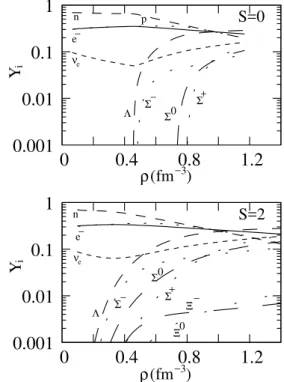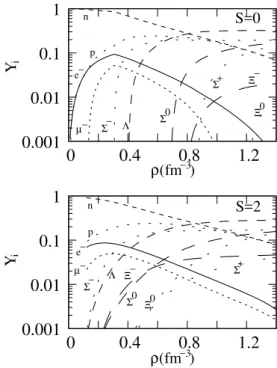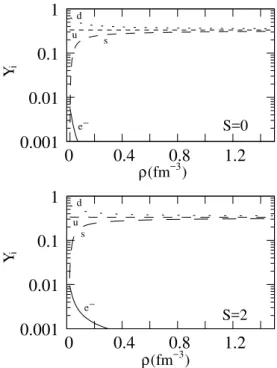Adiabatic index of hot and cold compact objects
R. H. Casali and D. P. Menezes
Departamento de F´ısica - CFM - Universidade Federal de Santa Catarina - Florian´opolis - SC - Caixa Postal 476 - CEP 88.040-900 - Brazil
(Received on 16 September, 2009)
In the present work we calculate the adiabatic index of neutron stars formed by hadronic or quarkionic matter, under two possible conditions, with and without trapped neutrinos, and for two values of the entropy per baryon S=0,2kB/baryon. We use the nonlinear Walecka model to describe hadronic stars, and the MIT bag model to
describe quark stars. Particle fractions for each case are obtained and the appearance of particles are compared with drops in the adiabatic index, whenever possible.
Keywords: Neutron stars; Quark stars; Adiabatic index
1. INTRODUCTION
The adiabatic index (Γ) is an important thermodynamical quantity. In a classical theory it is related to both the spe-cific heat at constant pressure and the spespe-cific heat at constant volume (Γ=Cp/Cv).
Compact stars are objects whose constituents can be used to build their equations of state (EOS) and consequently their adiabatic index, used to infer their stability [1, 2]. The compo-sition of neutron stars remains a source of speculation. Three of the possibilities are that 1) the stars are formed by hadrons plus leptons (hadronic stars) [3], 2) they are formed by quarks plus leptons (strange or quark stars) [4] and 3) that they are hybrid, formed by hadrons plus leptons and quarks plus lep-tons, bearing [5] or nor a mixed phase [6].
Polytropes are equations of state for which the adiabatic index is constant. A free Fermi non-relativistic (relativistic) gas can be described by an EOS withΓ=5/3(4/3). If the fermions are electrons, the resulting polytropic EOS can be used to describe white dwarfs. If they are neutrons, they de-scribe neutron stars [7, 8].
In [9, 10] piecewise polytropic EOSs are used to describe neutron star properties. In [10], a 4-parameter polytrope is used to fit hybrid star EOS obtained with more fundamental models, where the crust has an indexΓ1, the hadronic phase Γ2, the mixed phase an indexΓ3and the core constituted by quarks an indexΓ4. This piecewise EOS is then used in a study of constraints placed by astrophysical observations on neutron stars.
In the present work we calculate the adiabatic index for hadronic and quark stars both for zero temperature and fixed entropy per baryon. The non-linear Walecka model [11] is used to obtain the EOS for hadronic matter and the MIT bag model [12] for quark matter.
The paper is organized as follows: in Section II the ba-sic formalism used to describe hadronic and quark matter is briefly described. In Section III the results are presented and discussed and in the Section IV the final conclusions are drawn.
2. THE FORMALISM
We next describe the basic equations for the relativistic models used in the present work.
2.1. Hadronic stars
The Lagrangian density for the non-linear Walecka model can be written as [11]:
L
H=L
NLW M+L
l, (1)where
L
NLW M=∑
B
ψB
γµ ı∂µ−gυBVµ−gρB−→τ ·bµ
−MB∗
ψB+
1 2 ∂µφ∂
µφ−m2
sφ2
− 1 3!kφ
3
− 1 4!λφ
4−1 4ΩµνΩ
µν+1
2m 2
υVµVµ
−1 4Bµν·B
µν+1
2m 2
ρbµ·bµ
(2)
and
L
l=∑
l=e−,µ−
ψl(ıγµ∂µ−ml)ψl (3)
withΣBextending over the eight baryons and wheregiBand
miare respsctively the coupling constants of the mesonsi=
s,υ,ρ,δwith the hyperons and their masses. Self-interacting terms for theσ-meson are also included,kandλdenoting the corresponding coupling constants andτis the isospin opera-tor. The set of coupling constants of the baryons of the octect and the mesos aregsB=xsBgs,gυB=xυBgυ,gρB=xρBgρ,
andxsB, xυB andxρB are equal to 1 for the nucleons. We
have chosenxsB=0.7 andxυB=xρB=0.783 and assumed
that the couplings to theΣ andΞare equal to those of the Λ hyperon[11].As parameters we have used [11] g2s/m2s = 11.79f m2,g2υ/m2υ=7.148 f m2,g2ρ/m2ρ=4.410 f m2,k/M= 4.1684, λ =−41.3685, for which the binding energy is −16.3 MeV at the saturation density ρ0=0.153f m−1, the symmetry coefficient is 32.5MeV and the compression mod-ulus is 300MeV[11].MB∗= (MB−gsBφ) =0.70Mat the
sat-uration density represents the effective mass of each baryon. This parametrizations is often called GM1 in the literature.
After the application of the Euler-Lagrange equations to the Lagrangian density, the equations of motion for the nu-cleons and mesons read
φ0=− k 2m2
s
φ20− λ 6m2
s
φ30+
∑
B
gs
m2
s
V0=
∑
B
gυ m2
υ
xυBρB, (5)
b0=
∑
B
gρ m2
ρ
xρBτ3BρB, (6)
where:
ρsB=
1 2π
Z
p2d pM
∗
B
ε [fB++fB−], (7) and
ρB=
1 2π
Z
p2d p[fB+−fB−]. (8) The distribution functions for baryons and anti-baryons are:
fB±=
1
1+e[(εB∓νB0)/T], (9) with
εB= q
p2+M∗
B, νB0=µB−gνBV0−gρBτ3Bb0.
The expressions for the energy densityεand pressure
P
for the hadronic model are given by [11]:ε=εNLW M+εl (10)
with:
εNLW M=
1 π2
∑
B Z
p2d p q
p2+M∗2
B (fB++fB−)
+m 2 υ 2 V 2 0+
m2ρ 2 b
2 0+
m2s 2 φ 2 0+ k 6φ 3 0+ λ 24φ 4
0, (11) the energy density of the leptons is:
εl=
1 π2
∑
l Z
p2d p q
p2+m2
l(fl−+fl+), (12)
and
P
=P
NLW M+P
l, (13)with
P
NLW M= 1 3π2∑
B
Z p4d p p
p2+M∗2(fB++fB−)
+m 2 υ 2 V 2 0+ m2 ρ 2 b 2 0− m2 s 2 φ 2 0− k 6φ 3 0− λ 24φ 4
0, (14) the pressure of the leptons is:
P
l= 1 3π2∑
l
Z p4d p q
p2+m2
l
(fl−+fl+), (15)
with the lepton distribution functions given by: fl±=
1
1+e[(εl∓µl)/T], (16)
whereµlis the chemical potential of the leptons and:
εl= q
p2l+m2l. (17)
From the thermodynamic potential the entropy density of the system can be written as:
s= 1 T
P
+ε−∑
B
µBρB−
∑
lµlρl !
, (18)
where the density of the leptons is:
ρl=2 Z d3p
(2π3)(fl+−fl−). (19) The condition of chemical equilibrium implies that:
µn=µp+µe−+µν e−.
The neutrino term in the above equation refers to an initial stage of the neutron star, when the neutrinos are still trapped in its interior. After this stage the chemical equilibrium con-dition becomes:
µn=µp+µe−, (20)
µΣ0=µΞ0=µΛ=µn,
µΣ−=µΞ−=µn+µe−,
µΣ+=µp=µn−µe−,
µµ−=µe−. (21)
The charge neutrality implies that:
∑
B
qBρB=ρe−+ρµ−. (22)
2.2. Quark stars
The MIT bag model [12] is used to describe quark matter. In this model the quarks are considered to be free in a bag. The energy density for the bag model can be written as:
ε=εMIT+εl, (23)
with
εMIT =3×2
∑
q=u,d,sZ d3p
(2π)3
q p2+m2
q (fq++fq−)
where the value 3 represents the number of colors, 2 repre-sents the spin degeneracy,mqis the mass of each quark and
the termBrepresents the bag pressure [12]. The expression forεl is given by the equation (12) and the pressure can be
written as:
P
=P
MIT+P
l, (25)with
P
MIT = 1 π2∑
q=u,d,s
Z d p p4 q
p2+m2
q
(fq++fq−)
−B, (26)
and the term
P
l is given by the equation (15). The density of the quarks is given by:ρq=
2×3 2π2
Z
p2d p[fq+−fq−], (27) and the distribution function for the quarks and anti-quarks are given by the Fermi distribution:
fq±=
1
1+e[(ε∓µq)/T]
, (28)
with ε=qp2+m2
q, µq or (−µq), being the values of the
chemical potentials of the quarks or (anti-quarks) of type q. We have used mu= md =5.5 MeV, ms =150 MeV,
B= (150MeV)4.
The relations between the chemical potential of the differ-ent particles imposed by chemical equilibrium are:
µs=µd=µu−+µe−,
µe−=µµ−.
For the charge neutrality we have imposed: ρe+ρµ=
1
3(2ρu−ρd−ρs). (29)
2.3. Adiabatic Index
For stars, the stability is related with the value of the adi-abatic index in its interior that has to be larger than 43 [13]. Our goal in the present work is to study the behavior of this parameter of the matter that constitutes the star. We use the expression [14]:
Γ= ε P
dP
dε, (30)
wherePandεstand respectively for the pressure and energy density of the model under consideration.
3. RESULTS
In the following we discuss the results obtained for hadronic and quark stars. Not only the adiabatic index, but also the corresponding particle fractions are displayed for each case. Whenever possible a correlation between the ap-pearence of the particles and the maxima and minima in the adiabatic index is established.
3.0.1. Hadronic stars
Figs. 1 and 2 show the particle fractions versus density for entropiesS=0kB/baryon (upper panel) andS=2kB/baryon
(lower panel), for the nonlinear Walecka model.
Fig. 1 shows the fractions of hyperons, nucleons, and lep-tons in a system with trapped neutrinos and fixed lepton frac-tionYl =0.4. In the upper panel all species appear up to
ρ∼0.8 f m−3. ForS=2k
B/baryon the baryonsΞ−andΞ0
already emerge atρ∼0.4 f m−3. At this point it is important to emphasize that the caseS=0 and trapped neutrinos is dis-played for academic purpose and for the sake of comparison with the other cases. It is well known that at zero temperature no trapped neutrinos are left in the star because their mean free path would be larger than the compact star radius.
Y
iY
i(fm )
−3ρ
(fm )
−3ρ
e−
e
ν
Σ− Σ0
Σ+
e−
e
ν
Σ− Σ0
Σ+ Ξ−
Ξ0
n p
Λ
n
Λ
S=0
S=2
0.001
0.01
0.1
1
0
0.4
0.8
1.2
0.001
0.01
0.1
1
0
0.4
0.8
1.2
FIG. 1: Particle fractions for a hadronic star whit trapped neutrinos.
In Fig. 2 the particle fractions in a system without trapped neutrinos are shown. In the upper panel, even after ρ∼ 0.8 f m−3baryonic species are emerging. In the lower panel, one can see that all species emerge beforeρ∼0.5 f m−3and the baryonic distribution stabilizes after ρ∼1.0 f m−3. In both cases we can see that the electric charge neutrality is conserved, while positively charged particles appear, the neg-ative hyperons have their population increased.
Yi
Yi
e−
µ− Σ−
Σ0
Ξ− Σ+
Ξ0
e−
µ−
Σ− Ξ−
Σ0 Ξ0
Σ+
−3
(fm )
ρ
−3
(fm )
ρ
n
p
Λ
n
p
Λ
S=0
S=2
0.001
0.01
0.1
1
0
0.4
0.8
1.2
0.001
0.01
0.1
1
0
0.4
0.8
1.2
FIG. 2: Particle fractions for a hadronic star whitout trapped neutri-nos.
Fig. 3, shows the behavior of the adiabatic indexΓversus the baryonic densityρforS=0kB/baryon (upper panel) and
forS=2kB/baryon (lower panel) for stars with and without
trapped neutrinos. ForS=0kB/baryon, we can identify the
apperance of particles with deflections in the curves of the adiabatic index. ForS=2kB/baryon the identification is not
possible.
1 1.5 2 2.5 3
0.2 0.3 0.4 0.5 0.6 0.7 0.8 0.9 1
Γ
ρ (fm-3)
S=0 Σ
-Λ Λ Σ
-Σ0 Σ0
Ξ -Σ+ Σ+ WITH TRAPPED NEUTRINOS WITHOUT TRAPPED NEUTRINOS 1.33
1 1.5 2 2.5 3
0.2 0.3 0.4 0.5 0.6 0.7 0.8 0.9 1
Γ
ρ (fm-3)
S=2 WITH TRAPPED NEUTRINOS WITHOUT TRAPPED NEUTRINOS 1.33
FIG. 3: The adiabatic indexΓversus densityρ.
The horizontal line sets the threshold of stability. As indi-cated in the upper pannel, the adiabatic index drops at densi-ties that correspond to specific hyperon thresholds. After the thresholds the equation of state is softened because of the new hyperon. The case with trapped neutrinos presents a region (ρ∼0.85 f m−3) where the adiabatic index becomes lower than the stability threshold 43. Notice that this only happens in the case referred to the non physical situation of zero tem-perature and trapped neutrinos.
In the lower pannel with higher entropy the behavior of the adiabatic index seems to be always stable no matter the value of the density.
3.0.2. Quarkionic stars
Figs. 4 and 5 show particle fractions for entropies S= 0 kB/baryon (upper panel) and S = 2 kB/baryon (lower
panel), for the MIT bag model.
In Fig. 4 we display a system consisting of quarksu,d,sand leptonse−andν
e. For both cases the particle fractions are
practically the same. The neutrino content increases at lower densities and then reaches a maximum value and stabilizes.
The electron fraction has a little decrease till it stabilizes, and its presence restricts the s quark content due to the electric charge conservation.
Fig. 5 shows the u,d,s quarks and e− fractions, without trapped neutrinos. For the two entropies considered the elec-tron content decreases quickly.
In Fig. 6 we plot the adiabatic index Γversus density ρ forS=0kB/baryon (upper panel) and forS=2kB/baryon
(lower panel) and the limit of stability. For both values of en-tropy, Γshows practically the same behavior for stars with and without trapped neutrinos, decaying slowly but never crossing the threshold of stability.
Yi
Yi
−3
(fm )
ρ
−3
(fm )
ρ
− e
e
ν
− e
e
ν d
u
s
d u
s
S=0
S=2
0.01
0.1
1
0
0.4
0.8
1.2
0.01
0.1
1
0
0.4
0.8
1.2
FIG. 4: Particle fractions for a quarkionic star whit trapped neutri-nos.
4. CONCLUSIONS
i
Y
i
Y
−3
(fm ) ρ
−3
(fm ) ρ
− e
− e d
u s
d
u s
S=0
S=2
0.001
0.01
0.1
1
0
0.4
0.8
1.2
0.001
0.01
0.1
1
0
0.4
0.8
1.2
FIG. 5: Particle fractions for a quarkionic star whitout trapped neu-trinos.
FIG. 6: The adiabatic indexΓversus densityρ, for
S=0,2kB/baryon. We have used the NLWM and the MIT
bag model to describe these systems.
We have concluded that for hadronic stars and zero temper-ature (S=0), there is a clear correlation between the appear-ance of particles and the behaviour of the adiabatic index. For larger entropies and for quark stars the correlation does not exist or is not obvious.
An obvious continuation of the present work would be the calculation of the adiabatic index for various values of the entropy between zero and 2 in order to mimic a protoneutron star evolution. The results could help the understanding of its stability during the deleptonization and cooling processes.
Once the adiabatic index for hadronic and quarkionic stars was obtained, the same procedure can be repeated in the in-vestigation ofΓfor hybrid stars. Contrary to what was done with piecewise polytropic EOS in [10], a continuous EOS as obtained in [5] can be used for the calculation of the adiabatic index. This work is under investigation.
Acknowledgments
This work was partially supported by CNPq (Brazil).
[1] R.B. Jacobsen,Plasma de quarks e gluons no interior de estre-las de nˆeutrons, Msc. dissertation, Instituto de Fsica, Universi-dade Federal do Rio Grande do Sul, 2007.
[2] R.H. Casali,Objetos estelares compactos quentes e seus ´ındices adiab´aticos, Msc. dissertation, Programa de P´os-Graduac¸˜ao em F´ısica, Universidade Federal de Santa Catarina, 2008. [3] A. L. Esp´ındola and D. P. Menezes, Phys. Rev.C 65, 045803
(2002); A.M.S. Santos and D.P. Menezes, Phys. Rev. C 69, 045803 (2004); R. Cavagnoli and D.P. Menezes, Braz. J. Phys. 35 B, 869 (2005); Jour. Phys.G 35, 115202 (2008).
[4] D.P. Menezes, C. Providˆencia, D.B. Melrose, J.Phys. G 32,1081 (2006).
[5] D.P. Menezes and C. Providˆencia, Phys. Rev.C 68, 035804 (2003); D.P. Menezes and C. Providˆencia, Phys. Rev.C 69,
045801 (2004); P.K. Panda, D.P. Menezes and C. Providˆencia, Phys. Rev.C 69, 025207 (2004); P.K. Panda, D.P. Menezes and C. Providˆencia, Phys. Rev.C 69, 058801 (2004).
[6] T. Tatsumi, M. Yasuhira and D.N. Voskresensky, Nucl. Phys. A 718(2003) 359c; Yu. B. Ivanov, A.S. Khvorostukhin, E.E. Kolomeitsev, V.V. Skokov, V.D. Toneev and D.N. Voskresen-sky, Phys. Rev.C 72, 025804 (2005).
[7] R. Tooper, Astrophys. J.,140, 434 (1964).
[8] L. Ferrari, G. Estrela and M. Malheiro, Inter. J. of Mod. Phys. E 16, 2834 (2007).
[10] J.S. Read,B.D. Lackey, B.J. Owenand J.L. Friedam, arXiv:0812.2163v1 [astro-ph].
[11] Glendenning N. K.,Compact Stars. Springer-Verlag: New-York,(2000).
[12] A. Chodos, R.L. Jaffe, K. Johnson, C.B. Thorne and V.F. Weis-skopf, Phys. Rev.D 9, 3471 (1974).
[13] M. Onsi, H. Przysiezniak, J.M. Pearson, Phys. Rev.C 50, 1 (1994).


